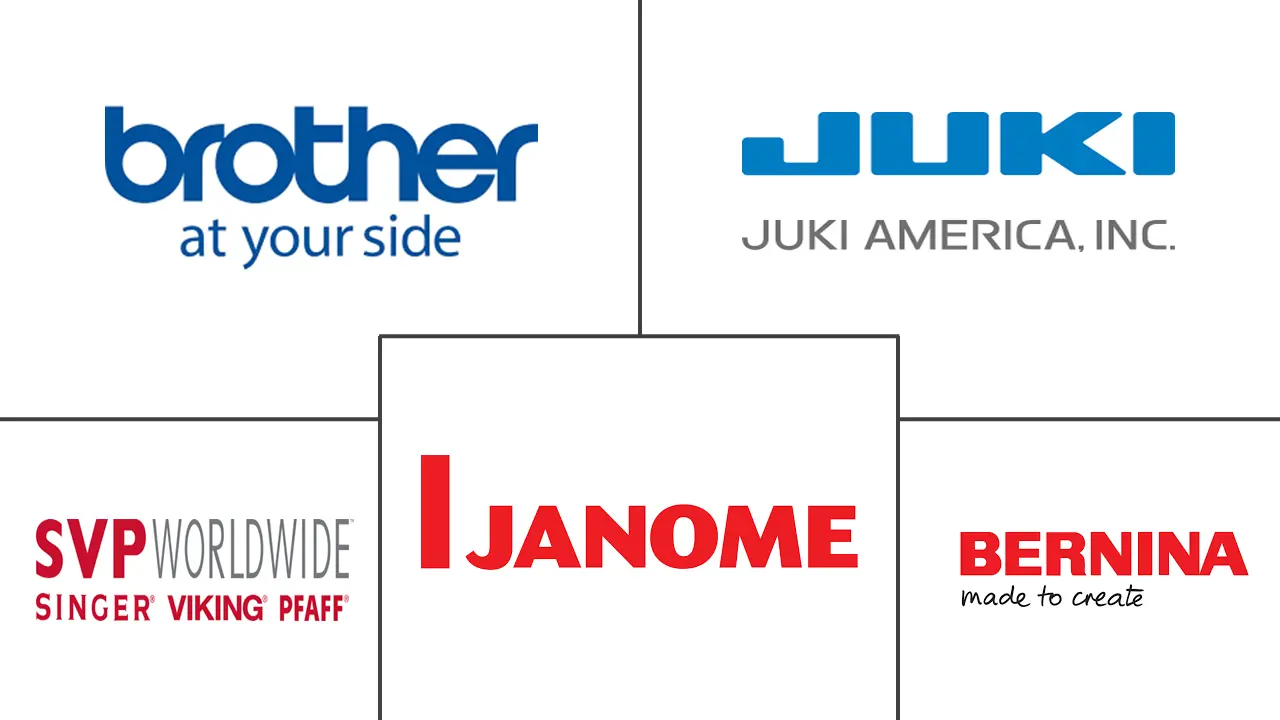Sewing Machines Market Size and Share
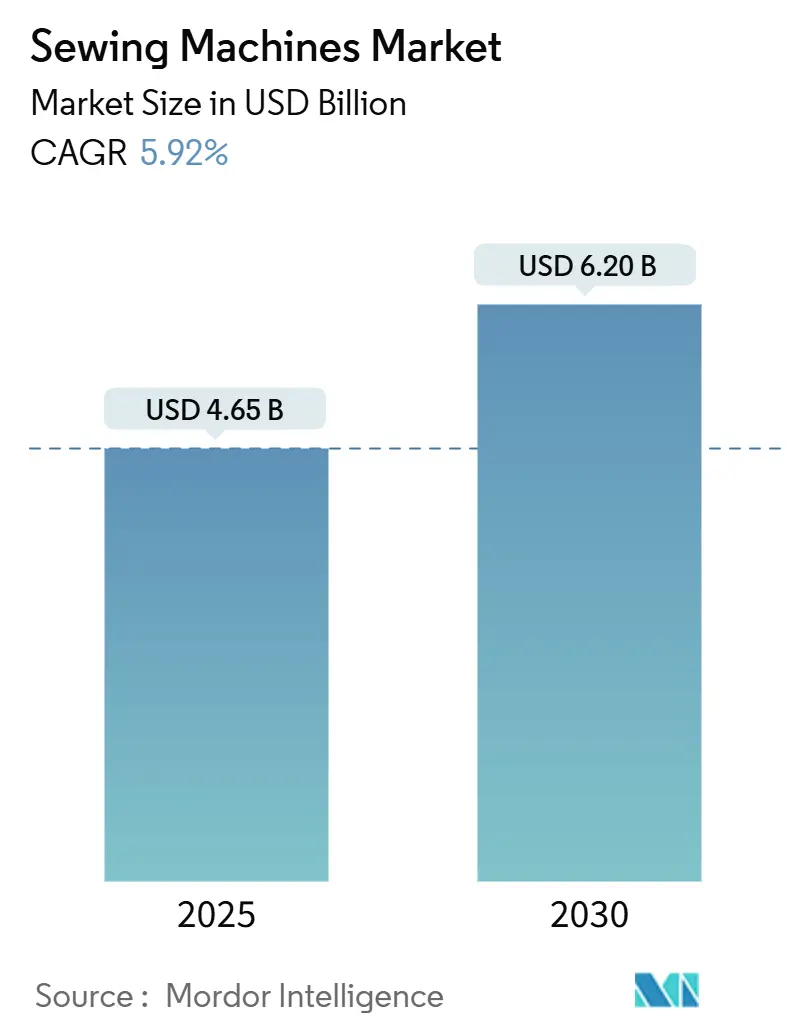
Sewing Machines Market Analysis by Mordor Intelligence
The sewing machine market attained a value of USD 4.65 billion in 2025 and is forecast to rise at a 5.92% CAGR to USD 6.20 billion in 2030. Industrial automation requirements power growth, the widening maker movement, and rapid feature upgrades that allow both factories and households to boost productivity while reducing waste. Manufacturers benefit from dual exposure: large‐volume textile exports in Asia and the repair-over-replace culture in North America and Europe. Technology upgrades toward Wi-Fi connectivity, downloadable stitch libraries, and programmable logic controllers lengthen replacement cycles yet raise average selling prices, supporting revenue even when unit volumes plateau. Near-shoring of garment production back to the United States and Western Europe further expands the addressable base for flexible, small-batch industrial systems that can switch styles without lengthy retooling.
Key Report Takeaways
- By machine type, electric models led with 65.00% revenue share of the sewing machine market in 2024; automated machines are projected to grow at 6.89% CAGR through 2030.
- By application, apparel accounted for 58.30% of the sewing machine market share in 2024, while home textiles are advancing at a 6.95% CAGR to 2030.
- By end user, industrial buyers held 74.60% of the sewing machine market size in 2024, but residential demand is expanding at 7.23% CAGR to 2030.
- By distribution channel, direct B2B sales captured 78.00% of the 2024 revenue of the sewing machine market; B2C online retail shows a 6.45% CAGR through 2030.
- By geography, Asia-Pacific dominated with 51.00% revenue share of the sewing machine market in 2024; the Middle East and Africa are the fastest-growing regions at 7.20% CAGR to 2030.
Global Sewing Machines Market Trends and Insights
Drivers Impact Analysis
| Driver | % Impact on CAGR Forecast | Geographic Relevance | Impact Timeline |
|---|---|---|---|
| Rapid apparel-manufacturing expansion in APAC | +0.9% | APAC core, spill-over to MEA | Medium term (2-4 years) |
| DIY & craft culture revival in mature economies | +0.7% | North America & EU | Short term (≤ 2 years) |
| Advancements in IoT-enabled and CNC sewing machines | +1.1% | Global | Long term (≥ 4 years) |
| Industrial automation push for productivity | +0.8% | Global, concentrated in manufacturing hubs | Medium term (2-4 years) |
| Near-shoring boosts demand for small-batch industrial units | +0.6% | North America & EU | Medium term (2-4 years) |
| Sustainability-driven "repair & reuse" consumer movement | +0.5% | Global, led by developed markets | Long term (≥ 4 years) |
| Source: Mordor Intelligence | |||
Rapid Apparel-Manufacturing Expansion in Asia-Pacific
Asia continues to outpace every other region in apparel output, fueled by public incentives and export-oriented strategies. India alone targets USD 350 billion in textile exports by 2030, stimulating bulk procurement of high-throughput sewing lines [1]“India Readies Roadmap to Reach USD 350 Billion Textile Exports by 2030,” Economic Times, economictimes.indiatimes.com . Production-linked schemes covering technical textiles lower the payback period on automated machines that handle multiple fabric weights without manual intervention. Growing wages in legacy low-cost centers push manufacturers toward units with servo motors and programmable stitch patterns that offset labor costs. Factory clustering in Vietnam and Bangladesh simplifies after-sales logistics, encouraging suppliers to embed regional service hubs. As orders shift from basic tees to higher-value athleisure and formalwear, demand tilts toward machines capable of complex seam constructions and digital platen adjustments.
DIY & Craft Culture Revival in Mature Economies
Gen Z consumers view home sewing as a route to personalized fashion and lower textile waste, and social media tutorials convert that interest into measurable hardware sales. Retailers now curate starter bundles that pair entry-level machines with downloadable patterns, easing the learning curve. Pandemic-era hobby adoption has persisted post-lockdown as a stress-relief habit, keeping retail sell-through high even as other home-improvement categories normalize. Compact form factors that fit small apartments and smartphone-like touchscreens resonate with digital natives, forcing brands to prioritize intuitive UX over mechanical complexity. The rising tide of reseller platforms for handmade items, such as Etsy, further monetizes the hobby, reinforcing equipment upgrades once users outgrow basic functions.
Advancements in IoT-Enabled and CNC Sewing Machines
Connectivity transforms the sewing machine market by turning hardware into continuously improving platforms. Singer’s SE 9185 lets users pull cloud-stored embroidery motifs directly onto the machine via Wi-Fi, cutting the pattern-transfer step entirely. On the shop-floor, Delta Galil fitted RFID scanners to track each garment section; the company reports double-digit reductions in rework after integrating stitch analytics with its MES dashboard. Predictive maintenance algorithms flag servo anomalies before downtime hits, raising asset availability and lowering spare-parts inventories. CNC-controlled feed mechanisms automatically adjust needle penetration to fabric density, curbing needle breakage and off-spec seams. Vendors monetize the data layer through subscription libraries, design marketplaces, and firmware upgrades, spawning recurring revenue streams that cushion cyclical demand swings.
Industrial Automation Push for Productivity
Textile producers pursue lights-out manufacturing models to mitigate rising wages and skill shortages. Servo motor retrofits alone can lift stitch-per-minute rates by 15% while trimming energy consumption according to JUKI’s field results [2]JUKI Corporation, “Servo Retrofit Efficiency Report,” juki.co.jp . Programmable logic controllers allow operators to load a new garment style in minutes instead of hours, enabling economically viable micro-runs. Robotics also appears in ancillary tasks such as panel stacking and inspection, complementing rather than replacing the sewing head. Capital-intensive upgrades remain viable where financing instruments such as vendor leasing and government modernization grants offset upfront outlays. Automation does, however, heighten the need for multidisciplinary technicians who understand both mechanics and software, spurring OEMs to bundle certification courses with equipment deliveries.
Restraints Impact Analysis
| Restraint | % Impact on CAGR Forecast | Geographic Relevance | Impact Timeline |
|---|---|---|---|
| High capital outlay for industrial machines | -0.7% | Global, acute in developing markets | Short term (≤ 2 years) |
| Proliferation of low-cost refurbished units | -0.5% | APAC & MEA primarily | Medium term (2-4 years) |
| Electronics supply-chain bottlenecks (MCUs, servos) | -0.6% | Global, severe in APAC manufacturing | Short term (≤ 2 years) |
| Shortage of skilled operators for advanced models | -0.5% | Global, critical in industrial segments | Medium term (2-4 years) |
| Source: Mordor Intelligence | |||
High Capital Outlay for Industrial Machines
Vendor financing options exist yet cover only the hardware, leaving training and maintenance outside loan packages. Banks often require collateral that small workshops lack, delaying modernization cycles and leaving production stuck with 10-year-old lockstitch units. Deferred investment saps competitiveness when brands demand tight tolerances on seam strength and digital traceability. Leasing programs introduced by JUKI in 2024 showed early adoption in Vietnam but remain a novelty elsewhere, partly because operators fear long-term commitment to proprietary software ecosystems.
Shortage of Skilled Operators
The adoption of automation is reducing reliance on line workers while increasing the demand for technicians skilled in optimizing PLC parameters and troubleshooting sensor systems. Rising wage premiums for these multi-skilled professionals are driving up operational expenses, thereby complicating the return on investment (ROI) justification for new equipment acquisitions. To address the skills gap, OEMs are incorporating step-by-step video tutorials into machine HMIs, though this solution provides only limited effectiveness. Collaborative efforts with vocational institutes in Indonesia and Mexico aim to create standardized training programs, but these partnerships require several years to yield a sufficiently skilled workforce. Consequently, businesses face a prolonged adjustment period before realizing the full benefits of automation-driven efficiencies.
Segment Analysis
By Machine Type: Electric Dominance Faces Automation Challenge
Electric models accounted for 65.00% of revenue in 2024, underscoring their versatility for factories and households alike. Many industrial buyers regard the segment as an interim step toward full automation, adding servo drives and semi-automatic thread cutters to stretch machine life cycles. Automated units, meanwhile, are slated to expand at 6.89% CAGR through 2030 as factories chase consistent stitch quality and lower rework. The sewing machine market size for automated systems is growing, reflecting rising demand from sportswear and technical-textile plants. Manual machines linger in regions with unstable electricity grids, carving out a defensible niche among artisans who prize tactile control.
Continued dominance of the electric segment derives from abundant spare parts and universal familiarity among operators, decreasing training periods. Singer’s Wi-Fi-ready M3330 illustrates how traditional categories absorb smart features without jumping to full CNC complexity. Hydraulically actuated quilting machines populate the “other” category and find success in mattress manufacturing, expanding geographic penetration into Turkey and Poland. Price gaps between electric and entry-level automated systems have narrowed to 18%, a threshold at which CFOs start green-lighting upgrades.
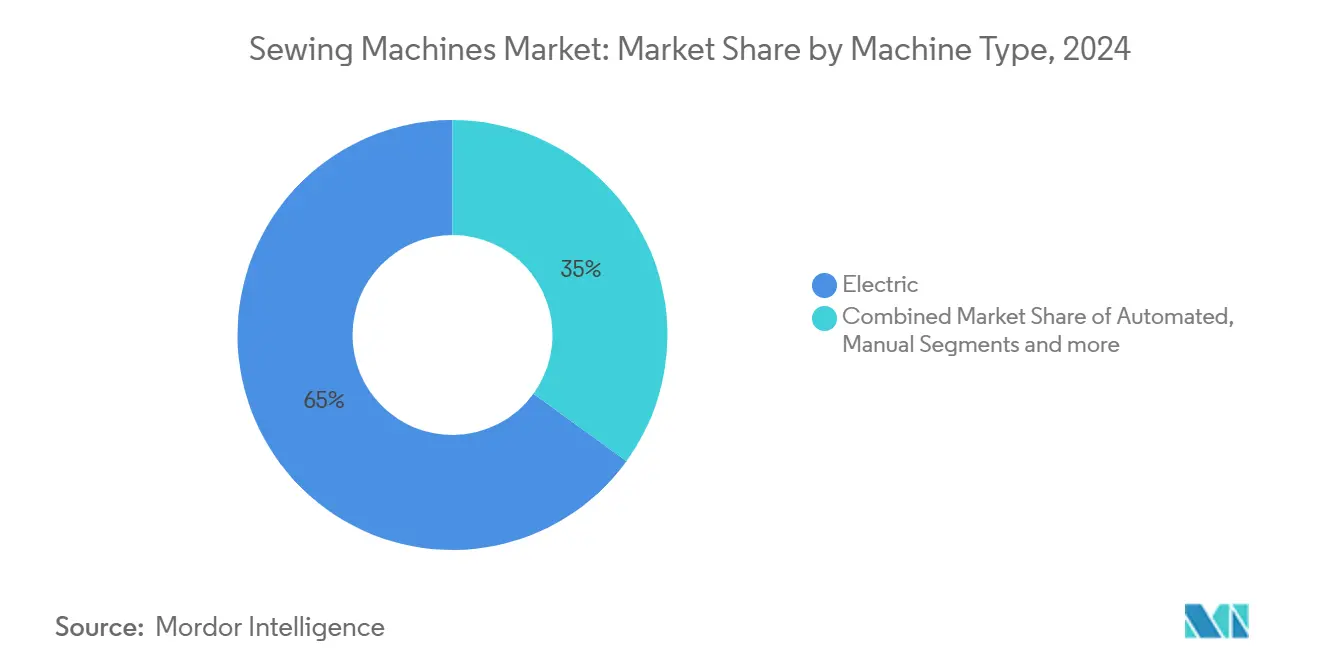
Note: Segment shares of all individual segments available upon report purchase
By Application: Apparel Leads While Home Textiles Surge
Apparel retained a commanding 58.30% slice of 2024 revenue due to vast order volumes from fast-fashion giants and uniform suppliers. Sportswear gains traction as stretch fabrics require differential-feed overlockers, prompting OEMs to bundle specialized presser feet. Home textiles, including curtains and cushion covers, represent the fastest-growing niche with a 6.95% CAGR as homeowners invest in personalized décor. The sewing machine market share for home-textile applications rose 120 basis points between 2023 and 2024, signaling a durable shift toward at-home customization. Automotive upholstery, medical disposables, and industrial filters round out the non-apparel group, each demanding heavy-duty needles and reinforced work tables.
Consumer preference for sustainable interiors boosts premium thread demand, benefiting subsidiaries like American & Efird that supply eco-dyed yarns. Car seat makers specify bar-tacking capabilities at 40 stitches per second, creating opportunities for providers that can integrate high-torque servo motors. In medical PPE, ultrasonic sewing alternatives compete, yet regulatory audits still favor stitched seams for critical gowns. Rising disposable income in urban India grows the market for embroidery-only machines that let users monetize home businesses. This diversification smooths cyclical dips in garment manufacturing, cushioning OEM revenue during apparel slowdowns.
By End User: Industrial Strength Meets Residential Renaissance
Industrial customers dominated the 2024 landscape with 74.60% revenue share, anchored by bulk purchases that replenish entire lines in synchronized intervals. Residential demand, however, clocks a 7.23% CAGR as hobbyists graduate from entry models to computerized units boasting 200+ built-in stitches. E-Learning portals shorten skill acquisition, broadening the appeal beyond traditional demographics. Corporate CSR programs that donate machines to women’s livelihood collectives also spur incremental sales in semi-urban belts.
Industrial orders often bundle service contracts and extended warranties that lift aftermarket revenue. Brands like JUKI co-locate spare parts depots near large buyer clusters in Ho Chi Minh City and Dhaka to guarantee a 24-hour turnaround. Residential buyers focus on aesthetics—sleek white casings and minimal knobs—yet still demand metal frames for stitch stability. Influencer tutorials on TikTok regularly highlight automated needle threading, ranking it among the top three must-have features for beginners. Downstream, refurbished industrial machines find second lives at small tailoring shops, extending the equipment ecosystem.
By Distribution Channel: B2B Dominance Faces Digital Disruption
Direct OEM sales captured 78.00% of total revenue in 2024, primarily because industrial buyers insist on application engineering and customized attachments. Multi-brand dealers serve as the bridge for small factories and home entrepreneurs, offering credit options that online platforms cannot yet replicate. The sewing machine market shows a 6.45% CAGR for B2C online channels through 2030, as consumers grow comfortable buying high-ticket items after watching unboxing videos. Exclusive brand outlets pop up in malls across Jakarta and Manila, giving manufacturers brand-building real estate while doubling as service centers. Subscription-based pattern libraries sold via in-app purchases transform machines into perpetual-revenue assets.
Warranty activation rates climb when buyers register units online, allowing OEMs to upsell presser-foot bundles and extended service packages. Online marketplaces often undercut MSRP by 10%, pressuring offline retailers to pivot toward experiential showrooms where shoppers test drive models. Freight cost remains a deterrent for fully assembled industrial units, which can weigh over 100 kilograms; hence, most online deliveries still focus on consumer products. B2B portals launched by SVP Worldwide aggregate spare parts and operator manuals, reducing service calls. This digitization introduces the possibility of predictive inventory stocking, where data from connected machines informs parts placement.
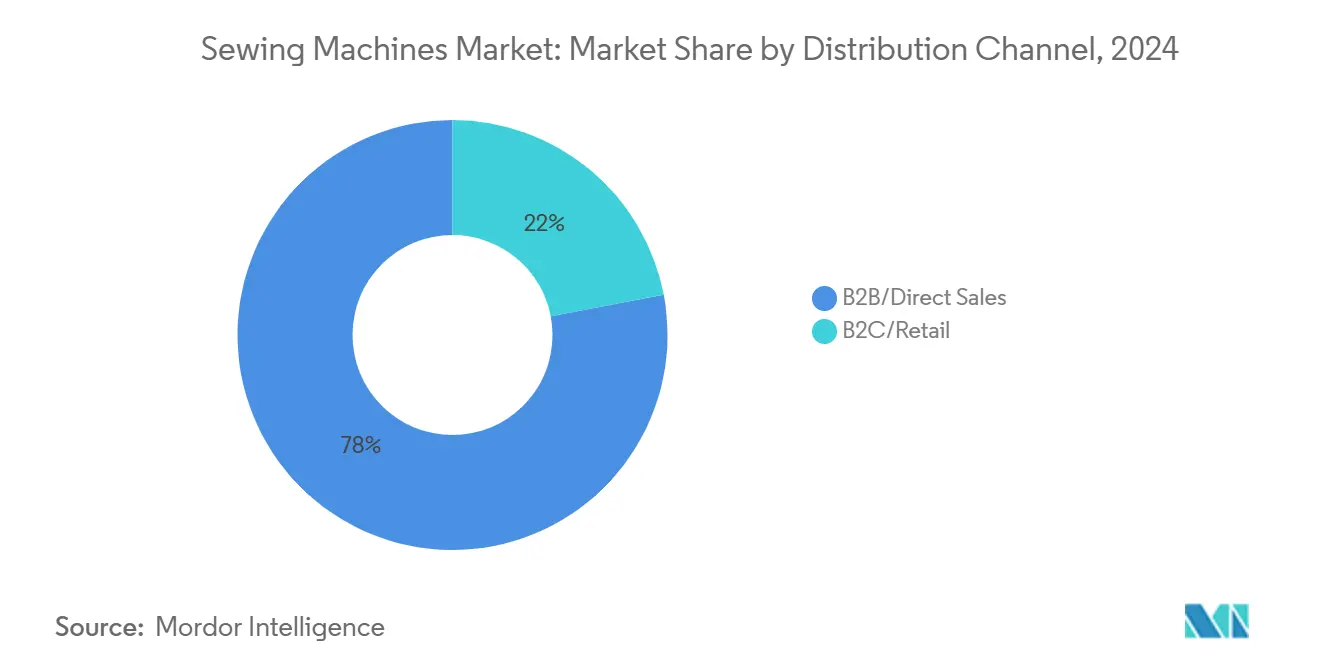
Geography Analysis
Asia-Pacific’s 51.00% revenue leadership in 2024 reflects its unmatched scale in fiber-to-fashion value chains and ascending middle-class consumption. India continues to roll out Production Linked Incentives that reimburse up to 15% of capital investment, prompting mills to modernize quickly [3]“PLI Scheme Spurs Textile Capex,” Economic Times, economictimes.indiatimes.com . Chinese OEMs increasingly supply servo components and human-machine interfaces to global brands, shortening lead times for feature updates. Vietnam’s apparel export growth encourages suppliers to build service warehouses in Ho Chi Minh City, reducing downtime for spare-part replacements. The region also witnesses swelling consumer enthusiasm for craft hobbies, as retail chains in Jakarta and Bangkok report double-digit sales lift for entry-level home units.
The Middle East and Africa grows the fastest, projected at 7.20% CAGR, supported by infrastructure corridors like Egypt’s Suez Canal Economic Zone that bundle industrial parks with duty exemptions. Ethiopia’s Hawassa Industrial Park already houses 25 apparel manufacturers that collectively imported more than 5,000 programmable lockstitch machines in 2024 according to customs data. Gulf Cooperation Council states encourage textile investments under Vision-2030 plans, with Saudi Arabia earmarking USD 500 million loans for integrated mills. African consumer markets also mature; Nigeria’s e-commerce platforms now list mid-range portable models that sell out during festival seasons. The challenge lies in training; OEMs partner with vocational institutes in Nairobi and Accra to certify operators on basic maintenance.
North America experiences a revival in domestic making, powered by consumers who value locally produced garments and by brands facing unpredictable trans-Pacific freight. Brands such as Nike pilot automated lines in Oregon that rely on CNC sewing heads capable of multi-material stitching. State-level grants in North Carolina and South Carolina subsidize equipment purchases for legacy mills upgrading to smart factories. Canada’s apparel SMEs embrace online configurators that allow end-users to design custom patterns, indirectly boosting demand for machines that accept digital input files. Mexico secures spill-over benefits as US buyers near-source to comply with quick-response retail models.
Europe blends mature industrial bases with avant-garde sustainability policies that redefine equipment specifications. Eco-design directives coming into force by 2027 will require precise energy-consumption metrics at the machine level, nudging OEMs toward high-efficiency servo motors. Germany continues to lead in technical textiles for automotive and aerospace, prompting demand for heavy-duty programmable bartackers. Italy’s luxury fashion houses employ specialized hand-guided embroiderers alongside automated equipment to uphold “Made in Italy” authenticity. Eastern European factories in Romania and Bulgaria win orders redirected from Asia due to logistics volatility, necessitating rapid scale-up in machine fleets.
South America exhibits steady momentum as Brazil’s garment cluster in Santa Catarina modernizes, deploying servo-motor retrofits to capture energy savings under rising electricity tariffs. Uruguay and Paraguay court Chinese investors for integrated cotton-to-apparel complexes that could localize equipment demand. Meanwhile, Chile’s e-commerce penetration fosters hobbyist uptake of compact home machines designed for small apartments. Currency fluctuations remain the principal headwind, often delaying purchase decisions for imported machines until exchange rates stabilize.

Competitive Landscape
The global stage is moderately consolidated, with the top five players holding more than half of the 2024 revenue. JUKI maintains a robust industrial footprint, leveraging seven decades of mechanical expertise and a presence in 185 countries to offer application-specific solutions ranging from denim chain-stitchers to mattress overclockers [4]JUKI Corporation, “Corporate Profile 2025,” juki.co.jp . Brother deploys aggressive R&D targeting fully automated shirt-placket units and cloud dashboards that visualize real-time seam density. Janome stresses user-friendly consumer interfaces, integrating voice-assisted tutorials in Japanese and English that guide beginners through setup. Dürkopp Adler captures automotive and footwear niches, supplying heavy-duty oscillating shuttle machines from plants in Germany and the Czech Republic.
Technology rivalry intensifies around IoT ecosystems that convert one-time sales into lifetime revenue through pattern subscriptions and predictive maintenance alerts. Singer’s in-house app “Sew It Forward” pushes weekly design drops and exclusive tutorials that generate micro-payments, creating lock-in for its Wi-Fi models. Industrial suppliers partner with software firms to layer AI algorithms capable of recommending optimum needle sizes based on fabric sensors. Component shortages elevate firms with backward-integrated motor production, cushioning margin hits from spot-market sourcing. Meanwhile, sustainability scrutiny pressures OEMs to publish carbon footprints for each model, an area where European players gain regulatory experience.
Crowdfunded start-ups experiment with open-source control boards compatible with third-party attachments, threatening the proprietary grip of incumbents. However, established players counter with global after-sales networks that newcomers struggle to match. Cross-licensing of patents on rotary hooks and differential feeds reduces litigation risks and accelerates multi-brand innovations. In 2025, collaborative consortiums have formed to standardize machine-to-MES communication protocols, supporting industry-wide digitalization.
Sewing Machines Industry Leaders
-
Brother Industries, Ltd.
-
JUKI Corporation
-
SVP Worldwide
-
Janome Sewing Machine Co., Ltd.
-
Bernina International AG
- *Disclaimer: Major Players sorted in no particular order
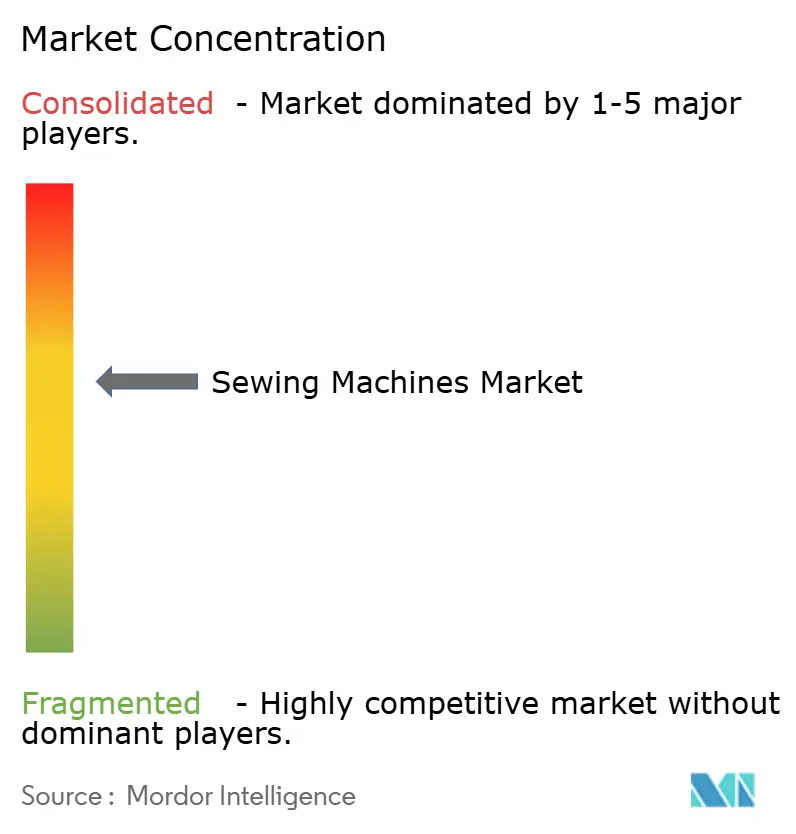
Recent Industry Developments
- May 2025: Singer India launched “SINGER Live Assist” for remote video troubleshooting.
- April 2025: Singer focuses on innovation and diversification, retaining its core black sewing machines with DSBB and SLBB while expanding into Husqvarna embroidery-cum-sewing machines and industrial machines with precision and 5000 stitches per minute speed.
- February 2025: Tonello S.r.l. Acquired Flainox S.r.l. to enhance capabilities in garment finishing technologies and dyeing machinery, expanding technological portfolio and market reach in sustainable textile production solutions
- May 2024: Singer India rolled out the M3330 and SE 9185 Wi-Fi machines aimed at Gen Z hobbyists.
Global Sewing Machines Market Report Scope
A complete background analysis of the sewing m market, which includes an assessment of the national accounts, economy, and the emerging market trends by segments, significant changes in the market dynamics, and the market overview.
| Manual |
| Electric |
| Automated |
| Other Machine Types |
| Apparel & Fashion |
| Non-apparel Textiles (Automotive, Upholstery) |
| Footwear & Leather Goods |
| Home Textiles & Crafts |
| Other Applications |
| Residential |
| Industrial |
| B2C/Retail | Multi-brand Stores |
| Exclusive Brand Outlets | |
| Online | |
| Other Distribution Channels | |
| B2B/Directly from the Manufacturers |
| North America | Canada |
| United States | |
| Mexico | |
| South America | Brazil |
| Peru | |
| Chile | |
| Argentina | |
| Rest of South America | |
| Europe | United Kingdom |
| Germany | |
| France | |
| Spain | |
| Italy | |
| BENELUX (Belgium, Netherlands, Luxembourg) | |
| NORDICS (Denmark, Finland, Iceland, Norway, Sweden) | |
| Rest of Europe | |
| Asia-Pacific | India |
| China | |
| Japan | |
| Australia | |
| South Korea | |
| South-East Asia (Singapore, Malaysia, Thailand, Indonesia, Vietnam, Philippines) | |
| Rest of Asia-Pacific | |
| Middle East and Africa | United Arab Emirates |
| Saudi Arabia | |
| South Africa | |
| Nigeria | |
| Rest of Middle East and Africa |
| By Machine Type | Manual | |
| Electric | ||
| Automated | ||
| Other Machine Types | ||
| By Application | Apparel & Fashion | |
| Non-apparel Textiles (Automotive, Upholstery) | ||
| Footwear & Leather Goods | ||
| Home Textiles & Crafts | ||
| Other Applications | ||
| By End User | Residential | |
| Industrial | ||
| By Distribution Channel | B2C/Retail | Multi-brand Stores |
| Exclusive Brand Outlets | ||
| Online | ||
| Other Distribution Channels | ||
| B2B/Directly from the Manufacturers | ||
| By Geography | North America | Canada |
| United States | ||
| Mexico | ||
| South America | Brazil | |
| Peru | ||
| Chile | ||
| Argentina | ||
| Rest of South America | ||
| Europe | United Kingdom | |
| Germany | ||
| France | ||
| Spain | ||
| Italy | ||
| BENELUX (Belgium, Netherlands, Luxembourg) | ||
| NORDICS (Denmark, Finland, Iceland, Norway, Sweden) | ||
| Rest of Europe | ||
| Asia-Pacific | India | |
| China | ||
| Japan | ||
| Australia | ||
| South Korea | ||
| South-East Asia (Singapore, Malaysia, Thailand, Indonesia, Vietnam, Philippines) | ||
| Rest of Asia-Pacific | ||
| Middle East and Africa | United Arab Emirates | |
| Saudi Arabia | ||
| South Africa | ||
| Nigeria | ||
| Rest of Middle East and Africa | ||
Key Questions Answered in the Report
What is the current value of the sewing machine market?
The sewing machine market stands at USD 4.65 billion in 2025 and is forecast to climb to USD 6.20 billion by 2030 at a 5.92% CAGR.
Which region dominates global sales?
Asia-Pacific leads with 51.00% of 2024 revenue, driven by massive textile export programs and rising consumer spending on craft hobbies.
What machine type is growing the fastest?
Fully automated units record the highest growth, expanding at 6.89% CAGR through 2030 as factories pursue labor savings and product consistency.
How are sustainability trends affecting demand?
Circular economy policies and “repair & reuse” consumer habits are boosting both residential sales and corporate interest in long-life, energy-efficient industrial models.
Who is the market leader in home sewing machines?
In 2025, SVP Worldwide, the parent company of Singer, Viking, and Pfaff, reported its revenue performance while maintaining a dominant position with approximately one-third share of the global household machine market.
What are the main restraints on market growth?
High upfront costs for industrial automation, a flourishing refurbished-machine market, component supply bottlenecks, and a shortfall of skilled technicians collectively trim projected growth by roughly 2.3 percentage points.
Page last updated on:
